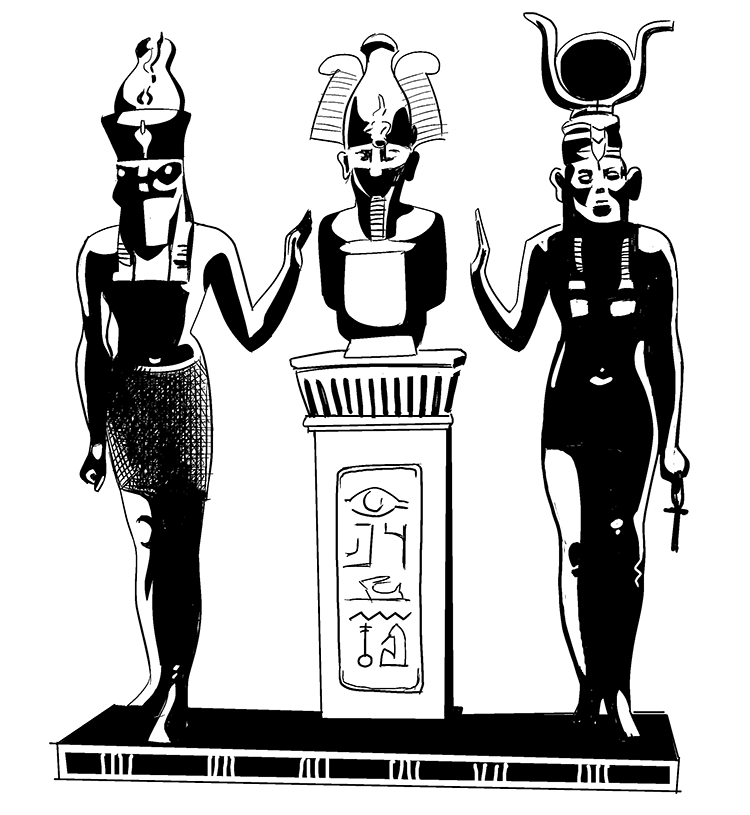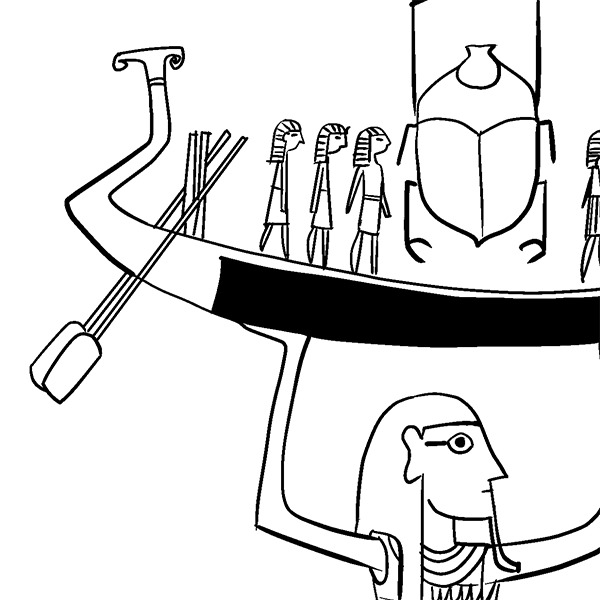When you hear the word “myth,” what do you think of? A story? A legend? Something that’s not true, right?
But, then, what is true? Ah, well, that’s a much more difficult question to answer. In the end, though, what’s true to us is what we believe. And once we believe something, it’s bound to have an influence on our life.
Mythology — or the stories a culture tells to understand the cosmos and their place within it — is an important part of any society. Studying it can reveal how and why these people lived the way they did.
In ancient Egypt, mythology was woven into practically every aspect of life. No study of Egypt is complete without an understanding of their myths.

Major Myths of Ancient Egypt
Compiling all of the major myths from ancient Egypt into one list would be an impossible task. But there are a few that stand out as especially significant because of their influence on life and the course of Egptian history.
The Waters of Chaos and Maat
One of the biggest questions to plague humans is, “where do we come from?” The existence of the Earth and life on it is a mystery people have tried to solve since the beginning of time.
The Egyptians were no different. They too took a stab at explaining creation. For them, the world was created by the gods from “the waters of chaos.”
These “waters of chaos” are never fully described, but they are understood to be the “cosmos.”
This is significant because it means that, to the Egyptians, the world in which we live is actually one of order. A tough pill to swallow for most of us, but as compared to the waters of chaos, things here on Earth are looking pretty good.
Understanding the Earth as order within chaos gave birth to the concept of maat, which basically means cosmic order, truth, and justice. To the Egyptians, everything was about maat.
The pharaoh’s primary duty was to maintain maat, and regular people also saw this as their essential task. They carried out their daily functions as farmers, fishermen, basketweavers, etc. believing that their actions were part of a much larger whole that had to be maintained for life to persist.
This helped contribute to a state of relative harmony within Egyptian society. Everyone saw themselves as necessary and significant, and so no one really complained.
However, if maat was disturbed, either by an invasion from a foreign foe, or from hunger, or some other form of social unrest, the pharaoh was the first one to receive blame.
By no means a perfect system, this concept of maat and the Egyptians steadfast belief in it helped create a harmonious and productive society that would rise to the top of the ancient world.
The Sun God
In Egyptian mythology, the sun, personified by Ra, Atum, and Amun in different places and at different times, almost always has special significance.
Part of this goes back to the Egyptian creation story. As it’s told, the Earth emerged from the waters of chaos as a dry mound of land, but it wasn’t until the light and dryness of the sun came that life was able to survive.
This makes the sun the giver of life and an important symbol in Egyptian mythology.
Throughout its history, Egyptian rulers often tried to show their connection to the sun god, as well as other deities. Eventually, Amun and Ra actually merged to become one god, and this brought Egypt as close to monotheism — worship in just one god — as it would ever come.

Triad of Osorkon II
Many a Pharaoh such as Osorkon II in this sculpture represented themselves as the gold Osiris accompanied by the Goddess Isis (his sister and wife) and their son Horus. The representation of the pharaoh as a member of the family of gods was so common that these images and sculptures have a name. they are called triads and many scholars think this representation is in the origin of the holy trinity.
The Birth of Horus
One of the most important gods in Egyptian mythology is Horus. Projected as a falcon, Horus is also seen as the god of kings.
Most pharaohs would claim some sort of relationship to Horus, or perhaps even declare themselves to be an incarnation of the god, and this helped establish their rule.
You see, in Egypt, the gods were the ones who were really in charge. The pharaohs were just acting as gods on Earth. This made mythology an important part of government. To rule, the king had to establish a solid connection with the gods.
Because of Horus’ significance, the story of his birth also carries considerable weight in Egyptian mythology.
Horus is the son of Isis and Osiris, two important Egyptian gods in their own right. According to the story, Osiris was killed — dismembered, really — by his brother Set, the god of the desert. In her sorrow, Isis — Osiris’ wife — managed to put her husband back together just enough to be able to impregnate herself with a son. Don’t ask…
Osiris then died and went on to become the ruler of the underworld. Isis, on the other hand, took on the image of the divine mother and eventually gave birth to Horus, who rose up to become the king of the gods.
Isis warned Horus of his uncle, Set, a popular antagonist in Egyptian mythology whose only purpose is often to disrupt maat. There always has to be a bad guy!
Eventually, the two fight, and Horus wins, restoring order to the world.
This story not only tells us how Horus rose to be such an important god, but it also provides a link between mythology and government.
As the story goes, Set was the patron god of Upper Egypt, and Horus was that of Lower Egypt. Therefore, this story of Horus defeating Set was used by Egyptian kings to bring Egypt together as one nation.
With their god defeated, the Upper Egyptians would have no choice but to submit to a new king. When they did, Egypt as we know it was born.

The Afterlife
One major theme in Egyptian mythology is the afterlife. Maybe because life in Egypt was just that good, or maybe because they were just really afraid of death, but the Egyptians believed strongly that life on Earth did not end when you died.
Beyond that, they also believed that you went to the afterlife in your same body and with some of your things! Not a bad situation at all, really.
Therefore, a lot of life on Earth was lived out in preparation for the afterlife. For regular folks, this meant living their life in accordance with maat. Do your job, fulfill your role, and things will be fine.
For the wealthy, this meant amassing treasures and other luxuries to take with them. Just in case! They would store these things, and their bodies, in elaborate tombs. And sometimes these tombs could be massive. To give you an idea, the Great Pyramid of Giza is actually a tomb!
And they also had to make sure they lived their lives in accordance with maat.
Another thing this belief system did was make embalming and mummification an important practice in ancient Egypt. Since your body went with you, you needed to make sure your body stayed fresh.
This was so important that the Egyptians got really good at this practice. So good that bodies discovered thousands of years later were uncovered and looked like they had just been placed in the tomb.
Too Many Stories to Tell
This is just a sampling of some of the many stories that make up Egyptian mythology. We may read some of these today and consider them far-fetched or fantastical. But we must not place these modern judgments on ancient people.
The world is a confusing place, and the stories we tell about how it was created and how it works determines much of how we live our lives. In ancient Egypt it’s clear that these stories shaped the lives of the people and their entire understanding of existence.
Written by Matthew Jones
Illustrated by Pablo Velarde Diaz-Pache
